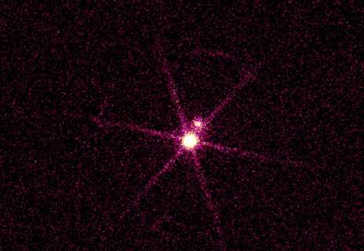
Even though there was observational support for Einstein's theory of General Relativity already in 1919, it was not generally accepted and incorporated in astronomical studies until much later. Many astronomers considered General Relativity too complicated and difficult to comprehend. But perhaps more importantly, astronomers had other worries. During the first decades of the 20th century they were greatly puzzled by the nature of the companion of Sirius. The mass of Sirius partner was estimated to be similar to that of the Sun from the double star orbit, but at the same time it was more than a hundred times dimmer. The obvious explanation that the star was faint because it was relatively cold failed. Stars radiate like black bodies so a cold star should be unmistakably red, but this peculiar star was observed to be white! The only possible conclusion was that the star must be small. This was confirmed by observations in 1925 and we now know that Sirius B, which is a so-called white dwarf, has a radius of about 10000 km.

Observations may have confirmed the extreme compactness of white dwarfs, but their internal constitution was not easy to understand given the knowledge of physics that was available in the mid 1920s. In fact, the structure of such compact stars seemed like an unavoidable paradox, and its resolution is a landmark in the development of our understanding of the internal structure of stars. The electron gas in matter as dense as in the companion of Sirius must be degenerate and should be described by quantum statistics. Basically, even an absolutely cold assembly of electrons must retain a spread of momenta (due to Pauli's exclusion principle), and if the electrons are confined to a finite volume (as in a star) there will be an associated pressure. It is this ``electron degeneracy'' pressure that balances gravity in white dwarfs.
So, what has this got to do with black holes and neutron stars? Well, a closer examination shows that the electrons in a massive dwarf will be moving at velocities near the speed of light. This means that any theoretical study of white dwarfs must include relativistic corrections. This turns out to have a surprising astrophysical implication. In July 1930 the then 19 year old Subramanyan Chandrasekhar, partly during the long sea voyage from India to England (where he was to become a student at Cambridge), made a calculation that predicted that white dwarfs can never be more massive than roughly 1.4 solar masses. This remarkable result implies that a massive star will not simply fade away as it runs out of nuclear fuel. Instead it will collapse under its own gravitational pull. This leads to a supernova explosion and the subsequent formation of either a neutron star or a black hole.
| For a star of small mass the natural white dwarf stage
is an initial step towards complete extinction. A star of large mass cannot
pass into the white dwarf stage and one is left speculating on other possibilities.
Chandrasekhar 1934 |
 |
Chandrasekhar's rather bold statement of the result led to an adverse reaction from Sir Arthur Eddington (one of the leading astrophysicists of the time). In a paper with which he followed Chandrasekhar's account of the white dwarf results at the January 1935 meeting of the Royal Astronomical Society, Eddington stated that: Various accidents may intervene to save the star, but I want more protection than that. I think there should be a law of Nature to prevent a star from behaving in this absurd way! Eddington never wavered in his rejection of the predicted mass limit for white dwarfs, but Chandrasekhar's result was correct and he was rewarded with the 1983 Nobel Prize in physics for his many outstanding contributions to our understanding of relativistic astrophysics.